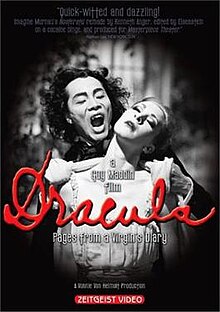Though it may not seem like it on the surface, we’re continuing our international doings today. Much like with Rabid a few days ago, we’re venturing back into the Great White North of Canada for a new take on a familiar story. Today, we’re talkin’ about Dracula: Pages from a Virgin’s Diary.

So the plot is foundationally the same as the usual Dracula mythos: Following a real estate deal, Transylvanian Count Dracula, a closeted vampire masquerading (so to speak) as a Victorian gentleman, makes his way to London, where he preys on a pair of otherwise innocent ladies, sparking the ire of their lovers and acquaintances. Unlike the traditional plot, though, things are taken a bit out of order here: Lucy Westenra takes center stage up front, dealing with being “infected” by Dracula’s curse before being dispatched by her suitors and Dr. Van Helsing. Then we switch over to Mina Harker – and here we also learn about her husband’s work with the aforementioned real estate deal and Dracula’s brides – as she becomes the Count’s next target, all before the final showdown begins.
Honestly, I have no problem with this rearrangement of events, especially since all of the necessary boxes are checked regardless. No, my issue comes with the overall presentation, courtesy of director Guy Maddin. The film is staged as a classic silent film, complete with monochromatic visuals (aside from some Sin City-style splashes of color here and there) and the occasional bit of Vaseline on the lens. Moreover, the action is rendered through the art of dance. Yup, you heard that right: Rather than your usual style of actors, this film is technically a staging of the Royal Winnipeg Ballet’s adaptation of Stoker’s novel. So rather than some stodgy Brits standing about and gabbing at each other, we get some mellifluous and sometimes frenzied dance movements.
This would all be fine, if a touch unconventional for a film, but Maddin made the absolutely mind-boggling decision to film these dancers in mostly close-ups and tight shots. And this goes for shots with both individual characters and groups, all of them engaging in some highly-choreographed dancing. I mean, I assume that, ‘cause I was never able to properly see said choreography. The shots are way too tight for any steps (do we call ballet maneuvers “steps”?) to be fully viewed, much less fully appreciated, and the editing is so manic that we’re unable to take anything in for much longer than a passing glance anyway.
And that’s a shame, ‘cause the bits we do see show some skill and talent from the cast, and the narrative, complete with a focus on Stoker’s themes of xenophobia (they went so far as to cast Asian actor Zhang Wei-Qiang as the Count to further emphasize her otherness from British high society) and sexuality, is a solid take on the novel. Unfortunately, all of these positives are paved over by obstreperous editing and downright confounding camera work. I’d say give the film a go if you wanna see a fairly radically different presentation of the story, but I’d caution any ballet fans to temper their expectations.
